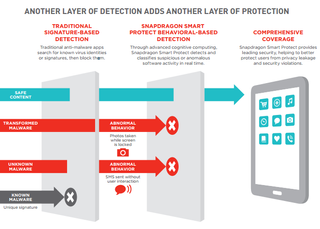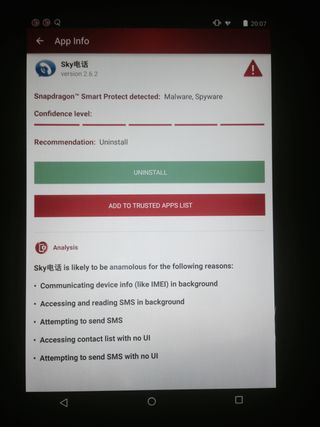Snapdragon 820's Zeroth Neural Chip Will Intuitively Block Malware On Smartphones

Qualcomm announced that the first main application for its Zeroth neural chip will be a malware behavior analysis feature called "Qualcomm Snapdragon Smart Protect." The feature will be free for OEMs to use, but it will be up to them to enable it on shipping devices.
Qualcomm's Zeroth chip uses "cognitive computing technology," which can enable "brain-inspired," on-device intelligence. The chip is meant to bring more natural interaction with devices and anticipate users' needs. Zeroth was designed to think like a biological brain and learn from its experiences in order to improve itself.
For instance, one of the first demos Qualcomm showed back in 2013 was a robot using Zeroth to find only white squares on a floor, but avoid other colored squares. The robot did this not because it was programmed in a certain specific way to reach the white squares, but because it "learned" by itself where the white squares would be. This is the main principle behind a neural processing unit (NPU) such as Zeroth, which is supposed to sit side-by-side a "traditional" CPU in devices.
The most exciting features that such a chip can provide will likely arrive later on, after developers have started using Qualcomm's Zeroth SDK to create innovative new mobile solutions that can improve people's lives. However, Qualcomm has already come up with what could be a solid use-case for Zeroth: malware behavior analysis.

Qualcomm can use the brain-like cognitive power of the Zeroth platform to detect "abnormal behavior" on mobile devices, which can include zero-day malware or "transformational malware," about which anti-virus solutions either don't know or the malware was modified to bypass them (in the latter's case).
This new feature that will arrive with the Zeroth platform is called "Smart Protect" and can exist in conjunction with signature-based anti-malware solutions from AVG, Avast, Lookout and others.
Smart Protect is part of Qualcomm's "Haven" security suite, which also includes the ultrasonic-based Sense ID 3D fingerprint authentication system, the SecureMSM technology (based on ARM's TrustZone), which can be used to keep sensitive data isolated from the mobile operating system, as well as the Snapdragon StudioAccess DRM solution and "SafeSwitch," used to protect devices against thefts.
Stay on the Cutting Edge
Join the experts who read Tom's Hardware for the inside track on enthusiast PC tech news — and have for over 25 years. We'll send breaking news and in-depth reviews of CPUs, GPUs, AI, maker hardware and more straight to your inbox.

Smart Protect should also help improve device privacy because the solution is local rather than "cloud-based" (which can allow other third-parties to know what you've installed when they scan for malware), and also because it can detect when other apps try to violate your privacy by sending data to their own servers without you being aware of it.
Qualcomm promised that Smart Protect will also use very little energy because it was optimized for mobile and has deep access to the hardware and software of the Snapdragon 820.
The Snapdragon 820 SoC, along with Zeroth, Smart Protect and Sense ID, are expected to come out in the first half of next year. Smart Protect should also be available with lower-tier Snapdragon processors in the future.
Follow us @tomshardware, on Facebook and on Google+.
-
bikerepairman1 I'm curious how it goes with illogical programming of an app. Would it be detected as malware or would it let it pass the screening?Reply -
InvalidError Not sure why a "neural chip" is necessary to prevent SMS getting sent or photos to get taken without user interaction or while the screen is locked. How hard can it be to lock out SMS/photo capabilities when there is no hardware activity on the touch-screen, hardware buttons or a locked screen?Reply
While there may be uses for neural processing, that particular example sounds like swatting flies using 20mm shells. -
dgingeri I have a program on my smartphone, AutoGuard Pro, that can take movies while the screen is locked, to act as a dashcam for the car. (It's actually a secondary program from the main one that does the recording while the screen is locked.) This sort of thing would block that, forcing me to use the full version of the program and leave the screen unlocked while driving, sometimes up to an hour and a half. That's troublesome.Reply
Most Popular





